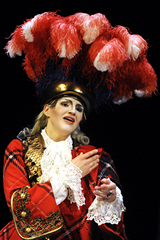| Opera Reviews | 24 April 2024 |
A visual delightby Catriona Graham |
|
| Handel: Amadigi di Gaula International Händel Festspiele Göttingen May 2012 |
|
|
Sigrid T'Hoofts' production of Amadigi di Gaula for the Internationale Händel Festspiele Göttingen is a visual delight. Heinz Kasper's blue lighting, the rich sapphire and scarlet of the costumes, the Baroque stance and gesture, the dancing, even the tinsel of the magic fountain fill the stage with colour and movement. Which is just as well. The plot is typically thin - best friends both in love with the same girl, interference from wicked witch who fancies hero, hero kills best friend, witch kills herself in despair at her inability to split the lovers, who live happily ever after. The particular twist (hence the tartan) is that the opera is based on a narrative which was an international bestseller in 16th century continental Europe and in which the eponymous Amadis travels to Scotland and ends up marrying Oriana the daughter of that famous English King Lisuart. The singing is superb. An all-female cast, they sing with a lightness and delicacy which makes the high artifice seem utterly natural, and without compromising the technical difficulties of the music. Among the moments of pure pleasure is Dardano's recitative and aria D'un sventurato amante / Pena tiranna - Markéta Cukrová duetting with Susanne Regel's liquid oboe augmented with a delicious bassoon line from Rhoda Patrick. Given he is lamenting that Oriana loves Amadigi, Melissa's (Judith Gauthier) response to present him with tartan seems odd. However, it is to disguise the somewhat hodden grey of his hose and studded breeches, so that he may win his love. Predictably, Oriana (Stefanie True) falls for this trick. Helping Melissa with her tricks are the dancers of the Corpo Barocco, who grimace and attitudinise in devilishly good style. Two are multi-breasted, another two have snakes writhing on skirts and headgear. They also appear as ladies in white dresses with tartan sashes and gentlemen in white breeches and jackets with tartan bunnets. Another glorious moment is Melissa's summoning of all the Furies to make war against Amadigi and Oriana, in which she is accompanied by the trumpet of Hans-Martin Rux. This is her response to Amadigi thwarting her plans by killing Dardano off-stage. However, his ghost appears in a cloud to tell her that the gods are protecting the lovers in spite of her and, in proof, when she tries to kill Oriana, she finds the star has disappeared from the end of her magic wand. Whereupon she kills herself and another cloud appears, from which emerges Oriana's uncle Orgando (local girl Johanna Ness), an enchanter, in the most amazing gold ankle boots tied with broad ribbons and the ultimate flouncy knickers in creamy-white. And what of Amadigi? Marieke Braun copes admirably with the multitasking of movement, gesture, singing and acting, all the while wearing that headgear - though she does take it off at one point for a wee snooze. In the pit, the Festspiel Orchester Göttingen conducted by Andrew Parrott is excellent, bringing out the very different styles in the music, whether plaintive aria or surprisingly Scottish-sounding dance. |
|
| Text ©
Catriona Graham Photo © Theodoro da Silva |

 Vivienne
Westwood, eat your heart out! From the first appearance of Marieke Braun
as Amadigi, in a red and blue tartan ensemble of coat over matching
knickerbockers and stockings, topped by fascinating headgear comprising
several Princes of Wales' feathers, it is clear that designer Stephan
Dietrich is a worthy rival.
Vivienne
Westwood, eat your heart out! From the first appearance of Marieke Braun
as Amadigi, in a red and blue tartan ensemble of coat over matching
knickerbockers and stockings, topped by fascinating headgear comprising
several Princes of Wales' feathers, it is clear that designer Stephan
Dietrich is a worthy rival. 





